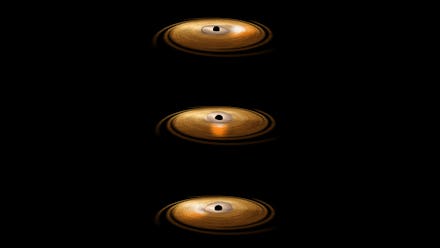Scientists Just Figured Out How Black Holes Twist Space-Time

Astronomers just solved a 30-year-old mystery about black holes, and it might give us a new way to test one of Einstein's most important ideas.
Back in the 1980s, astronomers discovered that black holes in our galaxy are ablaze with flickering X-rays, according to the California Institute of Technology. The flickering would follow a set pattern, getting steadily faster over a few months until stopping altogether.
They called the phenomenon quasi-periodic oscillation, or QPO. Astronomers suspected QPO happened due to the twisting of space-time that Albert Einstein predicted in his theory of general theory of relativity.
"It is a bit like twisting a spoon in honey," Adam Ingram, lead author on the new research, said in a statement. "Imagine that the honey is space and anything embedded in the honey will be 'dragged' around by the twisting spoon. In reality, this means that anything orbiting a spinning object will have its motion affected."
Scientists didn't have direct proof QPO came from this space-time warping... until now.
Ingram and his team used the NuSTAR telescope to look at the spiraling band of gas and dust around a black hole, called the accretion disk. Ingram noticed that X-rays coming from the accretion disk were influenced by the Doppler effect: what happens when waves travel around you. It's why sound waves from an ambulance siren sound really high-pitched as the ambulance approaches you, and then suddenly drop in pitch once it passes you.
In this case, the Doppler effect means the X-rays spiraling away from us around the accretion disk were stretched out, making the light appear more red, and the X-rays spiraling toward us were scrunched up, making the light appear more blue. The stretching and scrunching create a flickering effect as X-rays travel around the black hole, spiraling closer its center.
The pattern lined up with Einstein's theory of general relativity.
"We are directly measuring the motion of matter in a strong gravitational field near to a black hole," Ingram said.
The technique will allow astronomers to map the matter in accretion disks around black holes, according to NASA. It will also give us a way to test Einstein's theory as astronomers look at more black holes to see if they observe the same pattern.
Read more: